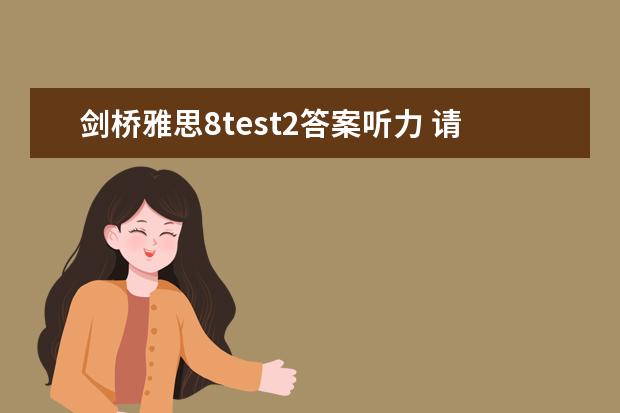当前城市:淄博[切换]
- 手机雅思无忧

扫码登录
今天雅思无忧小编整理了剑桥雅思8test2阅读p2 8月1日雅思阅读考试真题答案相关信息,希望在这方面能够更好的大家。

8月1号进行了八月初的第一场雅思的考试,相信大家对真题以及答案会非常的感兴趣、今天就由的我为大家介绍2020年8月1日雅思阅读考试真题答案。
一、考题解析
P1 土地沙漠化
P2 澳大利亚的鹦鹉
P3 多重任务
二、名师点评
1.8月份首场考试的难度总体中等,有出现比较多的配对题,没有出现Heading题,其余主要以常规的填空,判断和选择题为主。文章的话题和题型搭配也是在剑桥真题中都有迹可循,所以备考重心依然还是剑桥官方真题。
2. 整体分析:涉及环境类(P1)、动物类(P2)、社科类(P3)。
本次考试的P2和P3均为旧题。P2是动物类的话题,题型组合为:段落细节配对+单选+summary填空,难度中等。题型上也延续19年的出题特点,出现配对题,考察定位速度和准确度。P3也出现了段落细节配对,主要是段落细节配对+单选+判断。三种题型难度中等,但是文章理解起来略有难度。
3. 部分答案及参考文章:
Passage 1:土地沙漠化
题型及答案待确认
Passage 2:澳大利亚的鹦鹉
题型:段落细节配对+单选+Summary填空
技巧分析:由于段落细节配对是完全乱序出题,在定位时需要先做后面的单选题及填空题,最大化利用已读信息来确定答案,尽量避免重复阅读,以保证充分的做题时间。
文章内容及题目参考:
A 概况,关于一个大的生物种类
B 一些物种消失的原因,题干关键词:an example of one bird species extinct
C 一种鹦鹉不能自己存活,以捕食另一种鸟为生,吃该鸟类的蛋。题干关键词:two species competed at the expense of oneanother
D 吸引鹦鹉的原因以及鹦鹉嘴的特点。题干关键词:*ysis of reasons as Australian landscapeattract parrots
E 植物是如何适应鹦鹉。题干关键词:plants attract birds which make the animal adaptto the environment
F 南半球对英语的影响
G 两种鹦鹉从环境改变中获益并存活下来。题干关键词:two species of parrots benefit fromm theenvironment change
H 外来物种及本地鹦鹉
I 鸟类栖息地被破坏以及人类采取的措施
J 作者对于鹦鹉问题的态度
单选题:
why parrots in the whole world are lineal descendants of
选项关键词:continent split from Africa
the writer thinks parrots species beak is for
选项关键词:adjust to their suitable diet
which one is not mentioned
选项关键词:should be frequently maintained
填空题:分布在文章的前两段
one-sixth
16th century
mapmaker
John Gould
Passage 3:多重任务
题型:段落细节配对+单选+判断
参考答案及文章
28 F
29I
30C
31B
32G
33C
34B
35A
36YES
37YES
38NO
39NOT GIVEN
40NO
Passage3: multitasking
Multitasking Debate—Can you do them at the same time?
Talking on the phone while driving isn't the only situationwhere we're worse at multitasking than we might like to think we are. Newstudies have identified a bottleneck in our brains that some say means we arefundamentally incapable of true multitasking. If experimental findings reflectreal-world performance, people who think they are multitasking are probablyjust underperforming in all-or at best, all but one -of their parallelpursuits. Practice might improve your performance, but you will never be asgood as when focusing on one task at a time.
The problem, according to René Marois, a psychologist atVanderbilt University in Nashville, Tennessee, is that there's a sticking pointin the brain. To demonstrate this, Marois devised an experiment to locate nteers watch a screen and when a particular image appears, a red circle,say, they have to press a key with their index finger. Different colouredcircles require presses from different fingers. Typical response time is about half a second, and thevolunteers quickly reach their peak performance. Then they learn to listen todifferent recordings and respond by making a specific sound. For instance, whenthey hear a bird chirp, they have to say "ba"; an electronic soundshould elicit a "ko", and so on. Again, no problem. A normal personcan do that in about half a second, with almost no effort. The trouble comeswhen Marois shows the volunteers an image, then almost immediately plays them asound. Now they're flummoxed. "If you show an image and play a sound atthe same time, one task is postponed," he says. In fact,if the second taskis introduced within the half-second or so it takes to process and react to thefirst, it will simply be delayed until the first one is done. The largestdual-task delays occur when the two tasks are presented simultaneously; delaysprogressively shorten as the interval between presenting the tasks lengthens(See Diagram).
There are at least three points where we seem to getstuck, says Marois. The first is in simply identifying what we're looking can take a few tenths of a second, during which time we are not able tosee and recognise a second item. This limitation is known as the"attentional blink": experiments have shown that if you're watchingout for a particular event and a second one shows up unexpectedly any timewithin this crucial window of concentration, it may register in your visualcortex but you will be unable to act upon it. Interestingly, if you don'texpect the first event, you have no trouble responding to the second. Whatexactly causes the attentional blink is still a matter for debate.
A second limitation is in our short-term visual 's estimated that we can keep track of about four items at a time, fewer ifthey are complex. This capacity shortage is thought to explain, in part, our astonishinginability to detect even huge changes in scenes that are otherwise identical,so-called "change blindness". Show people pairs of near-identicalphotos -say, aircraft engines in one picture have disappeared in the other -andthey will fail to spot the differences (if you don't believe it, check out theclips at /~rensink/flicker/download). Here again, though, thereis disagreement about what the essential limiting factor really is. Does itcome down to a dearth of storage capacity, or is it about how much attention aviewer is paying?
A third limitation is that choosing a response to astimulus -braking when you see a child in the road, for instance,or replyingwhen your mother tells you over the phone that she's thinking of leaving yourdad -also takes brainpower. Selecting a response to one of these things willdelay by some tenths of a second your ability to respond to the other. This iscalled the "response selection bottleneck" theory, first proposed in1952.
Last December, Marois and his colleagues published apaper arguing that this bottleneck is in fact created in two different areas ofthe brain: one in the posterior lateral prefrontal cortex and another in thesuperior medial frontal cortex (Neuron, vol 52, p 1109). They found this byscanning people's brains with functional MRI while the subjects struggled tochoose among eight possible responses to each of two closely timed tasks. Theydiscovered that these brain areas are not tied to any particular sense but aregenerally involved in selecting responses, and they seemed to queue theseresponses when presented with multiple tasks concurrently.
Bottleneck? What bottleneck?
But David Meyer, a psychologist at the University ofMichigan, Ann Arbor, doesn't buy the bottleneck idea. He thinks dual-taskinterference is just evidence of a strategy used by the brain to prioritisemultiple activities. Meyer is known as something of an optimist by his has written papers with titles like "Virtually perfect time-sharing indual-task performance: Uncorking the central cognitive bottleneck"(Psychological Science, vol 12, p101). His experiments have shown that withenough practice -at least 2000 tries -some people can execute two taskssimultaneously as competently as if they were doing them one after the suggests that there is a central cognitive processor that coordinates allthis and, what's more, he thinks it uses discretion: sometimes it chooses todelay one task while completing another.
Even with practice, not all people manage to achieve thisharmonious time-share, however. Meyer argues that individual differences comedown to variations in the character of the processor -some brains are just more"cautious", some more "daring". And despite urban legend,there are no noticeable
differences between men and women. So, according to him,it's not a central bottleneck that causes dual-task interference, but rather"adaptive executive control", which "schedules task processesappropriately to obey instructions about their relative priorities and serialorder".
Marois agrees that practice can sometimes eraseinterference effects. He has found that with just 1 hour of practice each dayfor two weeks, volunteers show a huge improvement at managing both his tasks atonce. Where he disagrees with Meyer is in what the brain is doing to achievethis. Marois speculates that practice might give us the chance to find lesscongested circuits to execute a task -rather like finding trusty back streetsto avoid heavy traffic on main roads -effectively making our response to thetask subconscious. After all, there are plenty of examples of subconsciou*ultitasking that most of us routinely manage: walking and talking, eating andreading, watching TV and folding the laundry.
But while some dual tasks benefit from practice, otherssimply do not. "Certain kinds of tasks are really hard to do two atonce," says Pierre Jolicoeur at the University of Montreal, Canada, whoalso studies multitasking. Dual tasks involving a visual stimulus andskeletal-motor response (which he dubs "in the eye and out the hand")and an auditory stimulus with a verbal response ("in the ear and out themouth") do seem to be amenable to practice, he says. Jolicoeur has foundthat with enough training such tasks can be performed as well together asapart. He speculates that the brain connections that they use may be somehowspecial, because we learn to speak by hearing and learn to move by looking. Butpair visual input with a verbal response, or sound to motor, and there's nodramatic improvement. "It looks like no amount of practice will allow youto combine these," he says.
For research purposes, these experiments have to be keptsimple. Real-world multitasking poses much greater challenges. Even the upbeatMeyer is sceptical about how a lot of us live our lives. Instant-messaging andtrying to do your homework? "It can't be done," he says. Conducting ajob interview while answering emails? "There's no way you wind up being asgood." Needless to say, there appear to be no researchers in the area ofmultitasking who believe that you can safely drive a car and carry on a phoneconversation. In fact, last year David Strayer at the University of Utah inSalt Lake City reported that people using cellphones drive no better thandrunks (Human Factors, vol 48, p 381). In another study, Strayer found thatusing a hands-free kit did not improve a driver's response time. He concludedthat what distracts a driver so badly is the very act of talking to someone whoisn't present in the car and therefore is unaware of the hazards facing thedriver.
“No researchers believe it's safe to drive a car andcarry on a phone conversation”
It probably comes as no surprise that, generallyspeaking, we get worse at multitasking as we age. According to Art Kramer atthe University of Illinois at Urbana-Champaign, who studies how ageing affectsour cognitive abilities, we peak in our 20s. Though the decline is slow throughour 30s and on into our 50s, it is there; and after 55, it becomes moreprecipitous. In one study, he and his colleagues had both young and oldparticipants do a simulated driving task while carrying on a conversation. Hefound that while young drivers tended to miss background changes, older driversfailed to notice things that were highly relevant. Likewise, older subjects hadmore trouble paying attention to the more important parts of a scene than youngdrivers.
It's not all bad news for over-55s, though. Kramer alsofound that older people can benefit from practice. Not only did they learn toperform better, brain scans showed that underlying that improvement was achange in the way their brains become active.
Whileit's clear that practice can often make a difference, especially as we age, thebasic facts remain sobering. "We have this impression of an almightycomplex brain," says Marois, "and yet we have very humbling andcrippling limits." For most of our history, we probably never needed to domore than one thing at a time, he says, and so we haven't evolved to be ableto. Perhaps we will in future, though. We might yet look back one day on peoplelike Debbie and Alun as ancestors of a new breed of true multitaskers.
以上就是雅思无忧小编给大家带来的剑桥雅思8test2阅读p2 8月1日雅思阅读考试真题答案全部内容,希望对大家有所帮助!
雅思培训 剑桥雅思听力8test2 雅思阅读 与听力怎么从5.5到6
剑桥雅思听力8test2 雅思阅读 与听力怎么从5.5到6
剑桥雅思8的test2阅读答案Test2Listening部分1Milperra2FirstClas
2023年10月11日 01:12 雅思阅读剑桥8test2答案 请问2023年5月20日雅思阅读考试真题及答案解析
雅思阅读剑桥8test2答案 请问2023年5月20日雅思阅读考试真题及答案解析
2023年5月4日雅思阅读考试真题及答案您好,我是专注留学考试规划和留学咨询的小钟老师。在追寻留学梦
2023年12月03日 20:16 雅思剑桥听力8test2 5月29日雅思听力考试真题与答案
雅思剑桥听力8test2 5月29日雅思听力考试真题与答案
求:剑八Test2雅思口语Part2arestaurant解析题目:Describearestaur
2023年10月09日 03:19 雅思剑桥8test2 听力 2023年8月31日雅思听力考试真题及答案
雅思剑桥8test2 听力 2023年8月31日雅思听力考试真题及答案
2021年5月29日雅思听力考试真题与答案在雅思听力考试中,很多同学不习惯外国人的讲话方式,导致听力
2023年10月10日 18:06 雅思听力剑桥8test2 5月29日雅思听力考试真题与答案
雅思听力剑桥8test2 5月29日雅思听力考试真题与答案
2021年5月29日雅思听力考试真题与答案在雅思听力考试中,很多同学不习惯外国人的讲话方式,导致听力
2023年10月10日 23:21 剑桥雅思听力8test2 来自剑桥雅思8真题听力 Test2(4-2)句子翻译
剑桥雅思听力8test2 来自剑桥雅思8真题听力 Test2(4-2)句子翻译
雅思阅读与听力怎么从5.5到6雅思阅读与听力怎么从5.5到6在日常教学过程中,很多考生在参加完雅思培
2023年10月11日 01:12 雅思剑桥雅思8test2听力 剑桥雅思8的test2阅读答案
雅思剑桥雅思8test2听力 剑桥雅思8的test2阅读答案
剑桥雅思8的test2阅读答案Test2Listening部分1Milperra2FirstClas
2023年10月12日 22:20 剑桥8test2雅思听力答案 2023年9月14日雅思听力考试真题及答案
剑桥8test2雅思听力答案 2023年9月14日雅思听力考试真题及答案
请问2023年11月23日雅思听力考试真题及答案您好,我是专注留学考试规划和留学咨询的小钟老师。选择
2023年10月12日 23:07 雅思剑桥8test2 听力答案 雅思听力单复数问题如何快速解答
雅思剑桥8test2 听力答案 雅思听力单复数问题如何快速解答
雅思听力单复数问题如何快速解答您好,我是专注留学考试规划和留学咨询的小钟老师。留学申请的每一步都充满
2023年10月13日 00:31 剑桥雅思8test2答案听力 请问2023年9月28日雅思听力考试真题及答案
剑桥雅思8test2答案听力 请问2023年9月28日雅思听力考试真题及答案
雅思听力单复数问题如何快速解答您好,我是专注留学考试规划和留学咨询的小钟老师。留学申请的每一步都充满
2023年10月13日 00:59